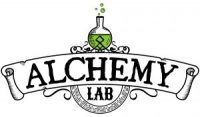An Interpretation of the Alchemy Lab Drawing
An Interpretation of the Alchemy Lab Drawing (by John Read)
The epitome of the spiritual alchemist, or religious mystic, is illustrated in a curious drawing of an alchemist in his laboratory, which appeared in Henry Khunrath’s Amphitheatrum Sapientiae Aternae (Amphitheater of Eternal Wisdom), published at Hanau, Germany, in 1609. Heinrich Khunrath was a theosophist, cabalist, and a Hermetic mystic of the most pronounced type, who has been claimed as “a hierophant of the psychic side of the Magnum Opus.“ This drawing was executed after Khunrath’s own design, apparently by a member of the de Vries family. The rendering is formal, and in some respects almost diagrammatic; the perspective effect is reminiscent of some of the work of Jan deVries and also of J. T. de Bry.
The numerous inscriptions are partly explanatory but mostly mystical. The tabernacle on the left is designated as the oratorium (or meditative enclosure); facing it, on the right, is the laboratorium (or laboratory). The tabernacle bears the name of the Lord in Hebrew characters, and on its left fold is a Latin inscription, Hoc Hoc agentibus nobis, aderit ipse Deus (When we attend strictly to our work, God himself will help us).
The kneeling alchemist is Khunrath himself or any alchemical adept. As he prays, his eyes rest upon a pentagram, the badge of the Pythagoreans. Perhaps he is praying in the spirit of George Ripley, canon of Bridlington in the foregoing century: “0h Unity in the substance, and Trinity in the Godhead! As thou didst make all things out of ONE chaos, so let me be skilled to evolve our microcosm [the Philosopher’s Stone] out of ONE substance in its three aspects of Magnesia, Sulfur, and Mercury.” The importance attached to music, harmony, number, and proportion in the operations of the Great Work, already suggested by the symbol of the pentagram, is emphasized by the musical instruments and pair of scales lying on the central table; moreover, the attached Latin inscription indicates that sacred music disperses sadness (or alchemical melancholia) and evil spirits. A star-like lamp with seven points, from each of which issues a small flame, hangs from the ceiling. These are the seven major operations of alchemy.
In the original drawing, the laboratory is adorned with many inscriptions. Nec temere, nec timide (Neither rashly nor timidly) and Sapienter retentatum, succedet aliquando (That which is wisely tried again will succeed sometime). The two outer pillars of the canopy over the alchemicaI hearth have a symbolical as well as a material significance, for they bear the words Ratio (Reason) and Experientia (Experience). Even the small still and athanor (furnace) shown in the foreground are provided with mystic inscriptions. The athanor, containing the scaled Vessel of Hennes, which may have to “stand in the Fire” for at least a philosopher’s month, is significantly labeled Festina lente (Hasten gently). Over the doorway at the far end are inscribed the words Dormiens vigila (While sleeping, watch). A set of eleven reagent bottles arranged above the canopy of this rarefied laboratory carry such apposite labels as : Hyle (primordial matter), Ros celi (dew of the sky), gold potab (potable gold), Azoth (Sophic Mercury), and Sanguis draconis (dragon’s blood).
In spirit, although not in material or design, Khunrath’s oratory-laboratory is akin to the alchemist’s cell that Bishop Hugh of Besancon constructed, according to Victor Hugo, in one of the ancient towers of Notre Dame in Paris early in the fourteenth century. Victor Hugo, depicting its appearance in the year 1482, describes it as “a sombre, dimly lighted cell,” with dust and cobwebs covering its chaotic assortment of compasses, alembics, bottles, retorts, skeletons of animals, manuscripts, and all the flotsam and jetsam of the alchemical practitioner. Its walls were covered with legends in many tongues and characters, and Latin inscriptions such as Unde? Inde? (Whence? Hence?); Homo homini monstrum (Man is a monster unto men); Sapere aude (Dare to be wise); and rhyming Latin jingles like Nomen numen (The name, a wonder) and Astra castra (The stars, a fortune). He described “the whole room crossed and recrossed in all directions with stars and triangles, human and animal figures, until the wall of the cell looked like a sheet of paper over which a monkey has dragged a pen full of ink.” Even the bellows bore the words Spiro spero (Blow, hope), a favorite slogan of the alchemical fraternity that must have been of enduring service to the puffer.




